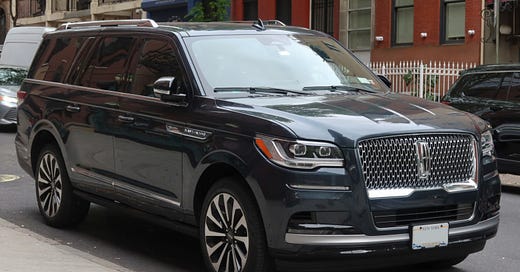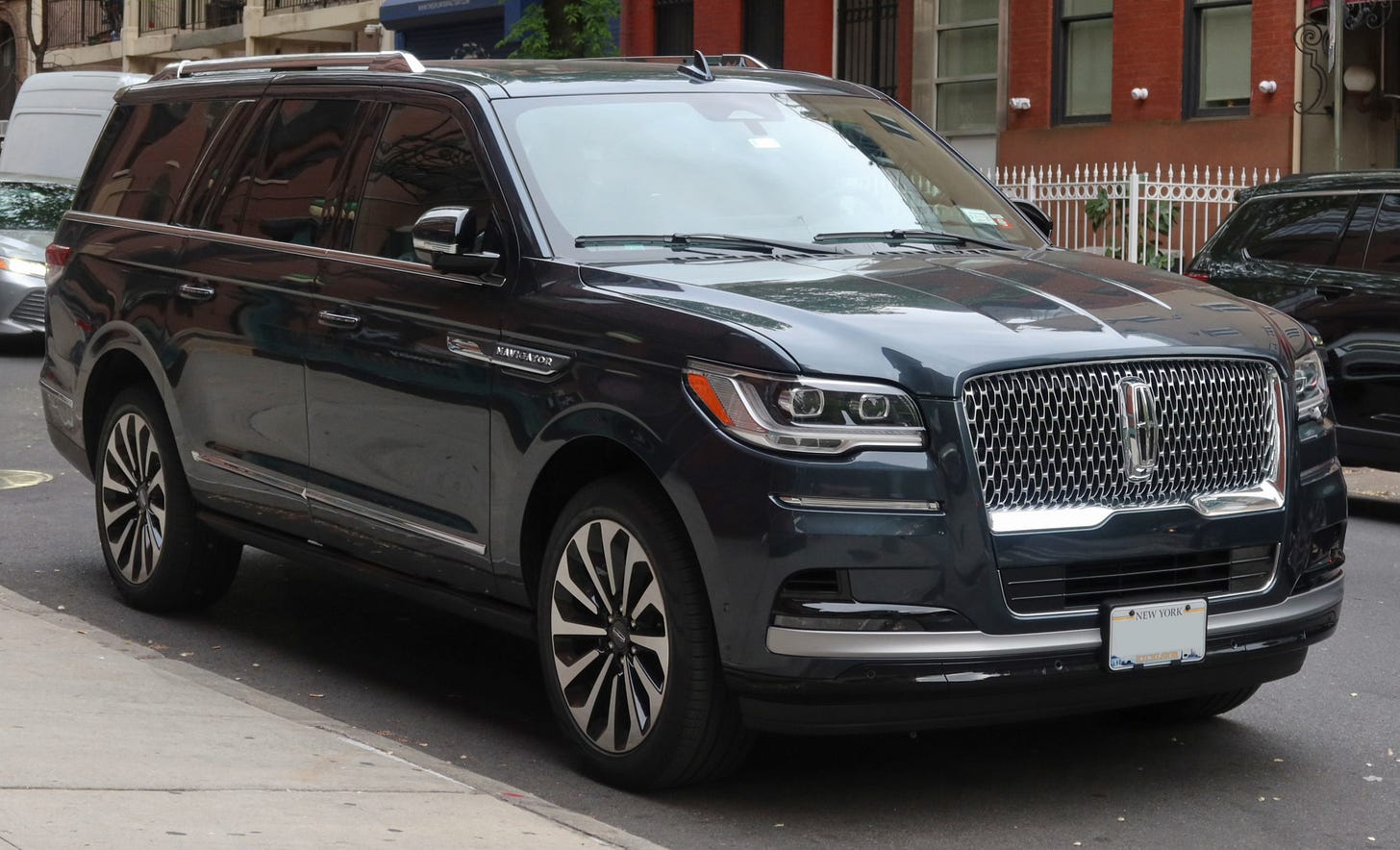Land of the Giants
How America’s Obsession with Gigantic Vehicles Is Killing the Planet and People
The other day, I was pulling up to a red light in our Prius. Tailgating me was a woman in an enormous black SUV, perhaps a Lincoln Navigator or a Cadillac Escalade it’s hard to say. She had her cell phone in her right hand and was alternating between gesticulating and steering with her left hand. She was maybe 10 feet behind me. I kept tapping my brakes in hopes that she would pay attention, to no avail. By some miracle she didn’t hit me but, if she had, she would have completely crushed my car.
Every day, I find myself struggling to see around these huge SUVs, jacked-up pickups, and even bigger RVs. If you drive a smaller, fuel-efficient car, these hulks are a serious hazard to seeing and being seen and life-threatening risk to life and limb.
Nonetheless, Americans love them—though they drive like, well, trucks. Manufacturers love them too since they garner much higher profits than sedans. Nowadays, even sports car manufactures like Porsche, Ferrari, and Lamborghini have gotten into the act, though an SUV as a sports car seems like an oxymoron.
It didn’t used to be this way. People used to drive sedans and station wagons, both of which have intrinsically lower aerodynamic drag and better gas milage. Unfortunately, there are now comparatively few sedans and it’s almost impossible to find a station wagon. Ford, for example, now only sells one sedan, everything else is a truck or SUV.
SUVs, even small ones like the Subaru Outback, have dramatically grown in size over the years. The Outback moved “from a smaller, zippier wagon to a larger, heavier vehicle.” Notably, for example, along with the increase in size, the Outback’s milage fell dramatically from 21.5/27.5 mpg to 18.5/25.5 between 2007 and 2008. Subaru isn’t doing this to deliberately harm the environment, but they are doing it to satisfy an American craving for oversized vehicles.
Pickup trucks have gotten bigger in lock step with SUVs. Between 1970 and 2024, the Ford F-250 pickup grew by an astonishing 9.5 inches in height, 26 inches in width, and 39 inches in length.
Likewise, according to the EPA, the average new pickup outweighed the average new sedan/wagon by a mere 45 pounds in 1975 but that difference grew to a deadly 1,700 pounds by 2018! For a more vivid comparison, SUVs are now approaching the size of the Sherman tank used by the US in WWII! (Now you know why it’s so hard to park these days.)
No matter how many technological advances we make, these giant beasts are going to continue to have a much larger climate footprint than sedans even if they are hybrids or electric. As cited by Jalopnik, trucks have the flattest recorded efficiency gains of any vehicles going all the way back to 1975. That same report shows that your average sedan has a fuel efficiency 34% higher than the average truck-based SUV (an SUV built on a truck chassis).
Considering that truck-based SUVs now make up 45% of market, with an ever-increasing market share, we have little hope of making a dent in US-based transportation climate footprint without a change in consumer habits.
Along with their terrible fuel economy, these vehicles are deadly. They are much heavier than the sedans that they crush in accidents, resulting in catastrophic damage to the sedans. For example, car drivers are 2.5 times more likely to be killed in collision with a pickup compared to a collision with another sedan.
Furthermore, the hood of these vehicles is so high that drivers can’t readily see children. These tall front ends strike children, pedestrians and cyclists in the torso or head whereas sedans typically strike the legs. This means that trucks and SUVs more often crush vital organs, resulting in death. Indeed, pickup trucks, notably the Chevy Silverado and the Ford F-150, are the vehicles most likely to kill both pedestrians and bicyclists.
How is this acceptable? There seem to be no laws restraining car companies in their quest to build ever bigger vehicles and there seems to be little movement to call out the ownership of these vehicles as both horrible for the planet and dangerous to human life.
If you travel to other countries, you will generally find far fewer SUVs and pickups on the road for many reasons. Culturally, and quite reasonably, many Europeans find these vehicles ridiculous, and they are working actively to discourage their use. Paris, for example, has voted to triple parking fees for SUVs in an effort to discourage them. More importantly, European gas prices, from $7.20 per gallon on up, discourage wasteful vehicles like trucks and SUVs.
We can fix this problem in the US. First, we must increase gas prices substantially if we are serious about combating climate change. If the wealthy want to continue to waste gas, then they should pay for it. The revenue derived from increased taxes on gasoline could go to lower-income drivers in the form of tax credits. Compared to today, we could even lower the cost of driving for the most vulnerable populations. The idea of raising gasoline prices is a political non-starter today but this may change as a warming climate imposes ever more dire consequences.
The second approach is cultural. We can talk to friends, family members and neighbors about purchasing a climate-friendly vehicle and we can turn up our noses a bit when they buy a truck or SUV (excepting construction workers, gardeners and the like who genuinely need them). This tactic really works. For example, we decreased smoking by making it socially unacceptable and we are starting to cut into the abuse of alcohol with the Dry January and Sober Curious movements. We need to make our opinions known.
Finally, we need to push our elected officials at the local, state, and federal level to make these vehicles less attractive in ways that are more politically acceptable than raising the price at the pump. For example, implement tighter CAFE fuel economy standards and a stringent minimum mpg for all vehicles (namely, no passenger vehicle of any sort can be manufactured that has a fuel efficiency below a certain threshold value). The State of California can substantially increase the annual fees for non-commercial, low-fuel-efficiency vehicles. Cities can increase the number of clean-air-only parking spots.
Aside from all of these big-picture solutions, your personal choices can make a substantial impact and save you money to boot. I’ll make a comparison of our car with the lady who almost rear-ended me. We drive a plug-in Prius and we recently went 2,500 miles on less than one tank of gas thanks to charging the car up every night. That gives us an average of 236+ mpg.
If that lady was indeed driving a Lincoln Navigator, she was getting an EPA estimated 19 mpg. Though not everyone can pull off ten times more mpg, almost everyone can get close to twice her fuel economy and cut their gas bill in half at the same time.
Joel Martin is a climate activist and writer for San diego350.org and The Jumping-Off Place. He is a scientist, semi-retired biotech entrepreneur, and long-time San Diego resident.






